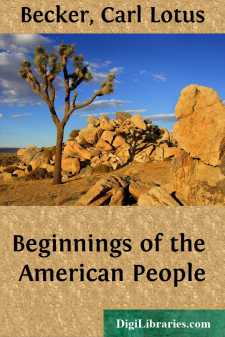Categories
- Antiques & Collectibles 13
- Architecture 36
- Art 48
- Bibles 22
- Biography & Autobiography 813
- Body, Mind & Spirit 142
- Business & Economics 28
- Children's Books 17
- Children's Fiction 14
- Computers 4
- Cooking 94
- Crafts & Hobbies 4
- Drama 346
- Education 46
- Family & Relationships 57
- Fiction 11829
- Games 19
- Gardening 17
- Health & Fitness 34
- History 1377
- House & Home 1
- Humor 147
- Juvenile Fiction 1873
- Juvenile Nonfiction 202
- Language Arts & Disciplines 88
- Law 16
- Literary Collections 686
- Literary Criticism 179
- Mathematics 13
- Medical 41
- Music 40
- Nature 179
- Non-Classifiable 1768
- Performing Arts 7
- Periodicals 1453
- Philosophy 64
- Photography 2
- Poetry 896
- Political Science 203
- Psychology 42
- Reference 154
- Religion 513
- Science 126
- Self-Help 84
- Social Science 81
- Sports & Recreation 34
- Study Aids 3
- Technology & Engineering 59
- Transportation 23
- Travel 463
- True Crime 29
Beginnings of the American People
Categories:
Description:
Excerpt
EDITOR'S INTRODUCTION
In the following volumes the authors seek to present a brief account of the beginnings, development, and final unity of the people of the United States. There are many histories of the country, many biographies which are in large measure histories; but these are exhaustive works traversing minutely certain periods, like Rhodes's History of the United States from 1850 to 1877, or Nicolay and Hay's Abraham Lincoln: A History; or they are shorter "patriotic" accounts which seek to prove something, or which fail to tell the whole story. Important as these classes of historical literature are, they hardly suffice for the teachers of advanced college classes, or for business and professional men who would like to know how the isolated European plantations or corporations in North America became in so short a time the great and wealthy nation of to-day.
To meet these needs, that is, to describe in proper proportion and with due emphasis, but in the brief space of four short volumes, the forces, influences, and masterful personalities which have made the country what it is, has not been an easy task. For, contrary to the view of European students, American history is not simple. The hostile camps of Puritans and Church of England men, the Dutch of New Amsterdam and the Catholics of Maryland, could hardly be expected to merge into a single state without violent struggle. Nor could the hundreds of thousands of Scotch Calvinists, militant enemies of England and all her ways, who seized and held the fertile highlands of the Middle and Southern colonies, submit quietly to any program not of their own making. And again, in the thirties and fifties of the nineteenth century, millions of people speaking a strange tongue sought asylum in the Mississippi Valley—an isolated region whose early inhabitants, of whatsoever national strain, were strongly inclined to secession or revolt against the older Eastern communities. Never was a nation composed of more diverse ethnic groups and elements.
And the geographical environments of these groups and segments of older civilizations were quite as dissimilar as those among which the nations of Europe developed. The cold and bleak hills of New England no more resemble the rich river bottoms of the South than the sand dunes of Prussia resemble the fertile plains of Andalusia. Geographical differences tend to produce economic differences. If to these be added inherited antagonisms like those of Puritan and Cavalier, one wonders how the East and the South of the United States ever became integral parts of one great social unit. Adding to this apparent impossibility the new antagonism of the West toward the East as a whole, the historian wonders at the statecraft that could hold the diverse elements together till certain economic and social factors became powerful enough to conquer in a long and bloody war. Or was it the influence of new inventions, railways, and the tightening bonds of commerce that did the work?
Leaving the reader to answer this question for himself, it remains for the Editor to set forth in as few words as possible the method, the emphasis, and the interpretations of the authors of these volumes....













